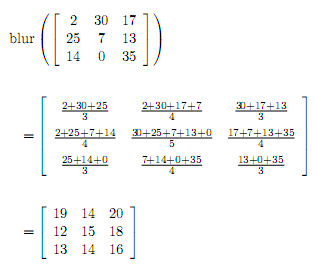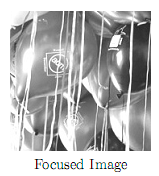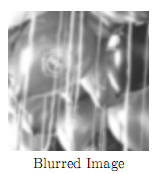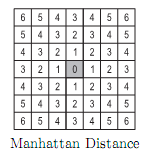988 . Kind of a Blur
Description
Image blurring occurs when the object being captured is out of the
camera’s focus. The top two figures on the right are an example of
an image and its blurred version. Restoring the original image given
only the blurred version is one of the most interesting topics in image
processing. This process is called deblurring, which will be your task
for this problem.
In this problem, all images are in grey-scale (no colours). Images are
represented as a 2 dimensional matrix of real numbers, where each cell
corresponds to the brightness of the corresponding pixel. Although
not mathematically accurate, one way to describe a blurred image
is through averaging all the pixels that are within (less than or equal
to) a certain Manhattan distance†
from each pixel (including the pixel
itself ). Here’s an example of how to calculate the blurring of a 3x3
image with a blurring distance of 1:

Given the blurred version of an image, we are interested in recon-
structing the original version assuming that the image was blurred as
explained above.



Input Format
Input consists of several test cases. Each case is specified on H + 1 lines. The first line specifies
three non negative integers specifying the width W, the height H of the blurred image and
the blurring distance D respectively where (1 ≤ W,H ≤ 10) and (D ≤ min(W/2,H/2)). The
remaining H lines specify the gray-level of each pixel in the blurred image. Each line specifies
W non-negative real numbers given up to the 2nd decimal place. The value of all the given real
numbers will be less than 100.
Zero or more lines (made entirely of white spaces) may appear between cases. The last line of
the input file consists of three zeros.
Output Format
For each test case, print a W*H matrix of real numbers specifying the deblurred version of the
image. Each element in the matrix should be approximated to 2 decimal places and right justified
in a field of width 8. Separate the output of each two consecutive test cases by an empty line. Do
not print an empty line after the last test case. It is guaranteed that there is exactly one unique
solution for every test case.
Sample Input 1
2 2 1 1 1 1 1 3 3 1 19 14 20 12 15 18 13 14 16 4 4 2 14 15 14 15 14 15 14 15 14 15 14 15 14 15 14 15 0 0 0
Sample Output 1
1.00 1.00
1.00 1.00
2.00 30.00 17.00
25.00 7.00 13.00
14.00 0.00 35.00
1.00 27.00 2.00 28.00
21.00 12.00 17.00 8.00
21.00 12.00 17.00 8.00
1.00 27.00 2.00 28.00
Hints
Problem Source
Migrated from old NTUJ.
ANARC 2009
Subtasks
| No. | Testdata Range | Score |
|---|